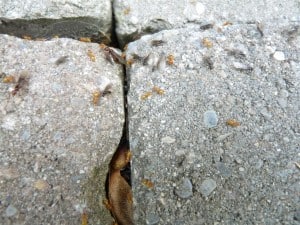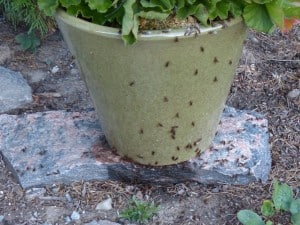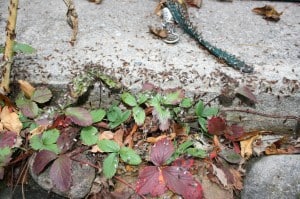On hot, muggy days in early September, we are often provided with an intriguing glimpse into the lives of ants, probably our most abundant insects. Although we don’t tend to think of ants as winged insects, they do have wings during the mating phase of their life cycle. This is when we see spectacular swarms of flying ants milling about on sidewalks, congregating around large rocks or trees, or flying high overhead.
Ants belong to a group of insects known as Hymenoptera, an order that also includes wasps, bees, and sawflies. Like monarch butterflies, they go through complete metamorphosis: egg to larva to pupa to adult. This process can take from several weeks to months. When you turn over a stone or log and see ants scurrying in all directions, you can often see the different stages of metamorphosis. First of all, you may notice that some ants are larger than others, and there may even be some with wings. You’ll also see ants carrying off small white things. These are the developmental stages and include eggs, larvae and pupae. The eggs tend to be extremely small, round and clumped in bunches. The larvae are usually a shiny, glistening, white colour and oblong in shape. The pupae, which are usually a little smaller than the adults, are sometimes in dull, parchment-like, cocoons.
Ant eggs, which are no larger than a period at the end of a sentence, hatch into a worm-like larva with no eyes or legs. An ant larva is a veritable eating machine which grows rapidly, thanks to a constant supply of food from the workers. Like caterpillars, the larva molts a number of times as it grows. When it reaches a certain size, it metamorphoses into a pupa. Pupae look more like adults, but their legs and antennae are folded against their bodies. In some ant species, pupae spin a cocoon for protection. However, in many others, they remain “ naked.” After this period of rest and reorganization of body structures, the pupa emerges as a light- coloured adult. Adults darken as they age.
Ants are the ultimate social insects. Their colonies are made up strictly of sterile females with the exception of a very brief period in which fertile, winged males and females are produced for the purpose of reproduction. The sterile females, which are known as workers, have the responsibility of caring for the queen and young, enlarging, repairing, and defending the nest, and gathering food. Individual ants can switch between these tasks without any one ant actually being “in charge.” Worker ants may live as long as six years and queens as long as fifteen.
As already noted, male ants exist for the singular purpose of reproduction. They hatch from unfertilized eggs, while females hatch from eggs that are fertilized. This means that males have only one set of chromosomes – from the mother – while females have two sets of chromosomes – from the mother and father. Males only live long enough to mate and thereby supply the females with a lifetime supply of sperm.
Mating takes place over the course of just one day in a phenomenon known as swarming. Swarming behaviour most often occurs in the afternoon, a few days after a heavy rain, when the weather is warm and humid. Thousands of winged males and much larger winged females emerge from the ground, usually pushed out by wingless workers. These “flying ants” sometimes form massive clouds of countless individuals. Copulation often occurs on the wing; however, the females play hard to get and allow only the most quick and nimble of the males to deposit their sperm. A queen will mate with several males. Swarming behavior is usually synchronized with other ant colonies of the same species so that it occurs on the exact same day. In this way, large numbers of winged ants suddenly appear over very large areas. The swarming of multiple ant colonies promotes interbreeding which increases genetic diversity and adaptability.
The male ants are attracted to powerful sex pheromones produced by the female. A pheromone is a chemical signal that sets off a response in another individual of the same species. There are, for example, sex pheromones, alarm pheromones, and food trail pheromones – to name a few. Some moths are able to detect sex pheromones from as far away as 10 kms!
An especially interesting behaviour of mating swarms in some species is known as “hilltopping.” In what is probably an effort to more easily find a mate, ants congregate around prominent points of a landscape such as a large tree, the chimney of a roof or a tower. At this time, they may inadvertently fall down chimneys into houses. However, there is no risk of permanent household infestation.
When ants are swarming, it is not uncommon to see predators such as dragonflies or birds grabbing the ants out of mid-air and quickly gobbling them up. Even ring-billed gulls, surprisingly nimble as aerial foragers, take advantage of this source of easy food. Several weeks ago, my wife and I watched as dozens of darner dragonflies feasted on flying ants that were swarming over a dock on Big Gull Lake. One of the dragonflies even landed on me and proceeded to devour its hapless prey.
When the swarming ceases, all of the male ants die, and each mated female begins the very difficult task of establishing her own new colony. The first thing she does is to shed her new wings by biting them off. You can often see wings lying about after swarming has occurred. The wing muscles, which are no longer needed for flight, become an important source of nutrients during the initial stages of colony development.
The queen will often then crawl under a rock, seal herself off from the outside world, lay eggs, and, without ever leaving the nest, raise the young to maturity. She feeds these wingless, non-sexually mature, female workers with her saliva. It contains protein from her wing muscle tissue which breaks down when the wings are shed. When the first brood of workers matures, they start expanding the colony by excavating the soil beneath the stone and depositing it in small mounds or craters. These “ant hills” are conspicuous along sidewalks and most anywhere there is exposed dirt. A colony requires several years to expand before sexually mature male and female ants with wings are developed. The colonies persist all winter long which is in marked difference to wasp colonies which collapse after the first heavy frost in the fall.
Ant species found in Canada are not aggressive, although some can sting. Most of the ants we commonly see in this area are formicine ants belonging to the genus Formica. They are typically black or black and red and are often seen on sidewalks. Formicine ants have a distinctive node (body part) between the thorax and the abdomen. Another way to identify them is to simply pick up one or two. You should be able to get a good whiff of formic acid. This chemical serves a number of purposes ranging from communication to defense.
One of the most common formicine ants is the black carpenter ant. They are infamous for sometimes damaging wood structures when excavating nests. These ants are general scavengers but do not actually eat the wood, contrary to common belief. Carpenter ants often watch over treehoppers and aphids – almost like shepherds tending a flock of sheep – in order to feed on the sugary honeydew that these insects excrete.
Carpenter ants also have a special relationship with the caterpillar of a group of butterflies known as blues (Lycaeinidae). The spring and summer azure, two common species of the Kawarthas, are members of this group . The ants play the role of the caterpillar’s bodyguards and protect it from dangers such as predators and parasitic wasps. In return, when stroked by the ants’ antennae, the caterpillar exudes a protein-rich nutrient from glands on its back. The ants lap this up.
Ants are also key to the success of many of our spring wildflowers. Early bloomers such as trilliums and violets produce seed, to each of which is attached a small pouch containing sweet liquid. Ants find this irresistible and hoard the seeds in their underground chambers. Once there, the seeds quickly germinate in the moist, dark soil.
Contrary to popular belief, there are no fire ants in Canada. The term “fire ants” refers to a select group of very aggressive ant species (Solenopsis) that were accidentally introduced into the southeastern states from South America. They only occur as far north as North Carolina.


